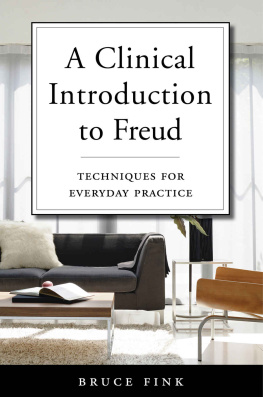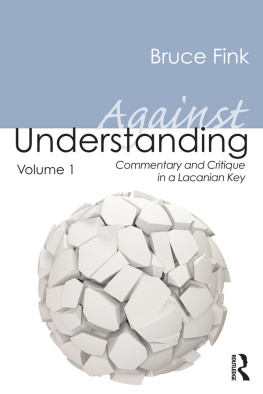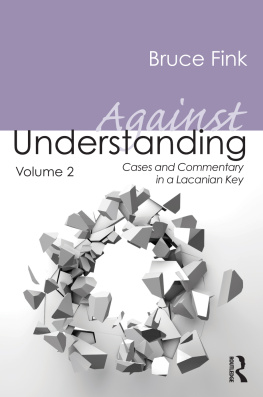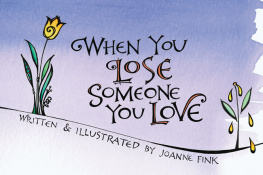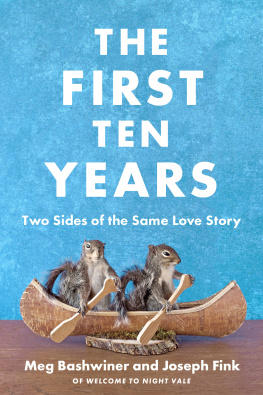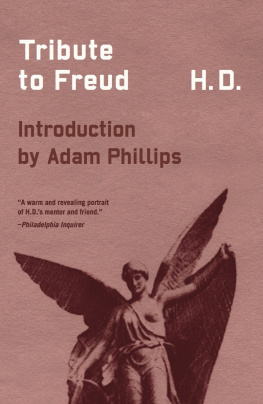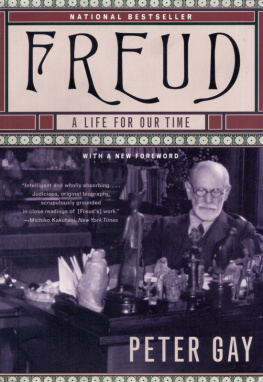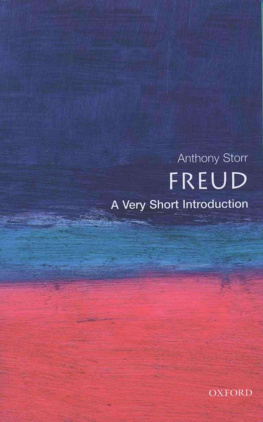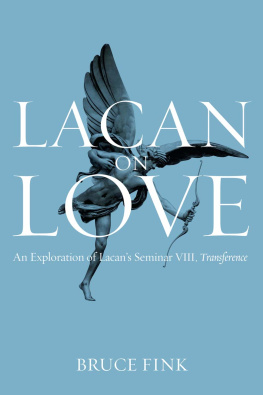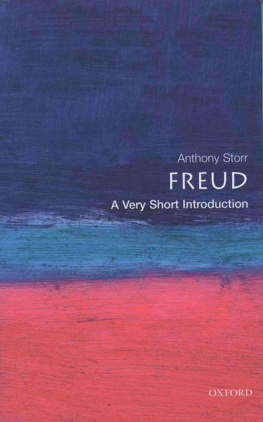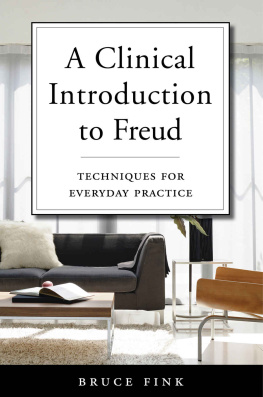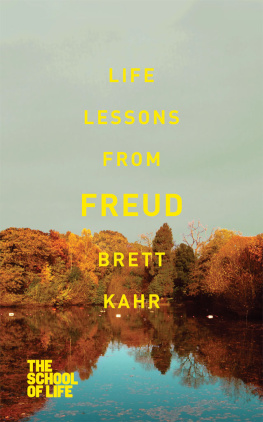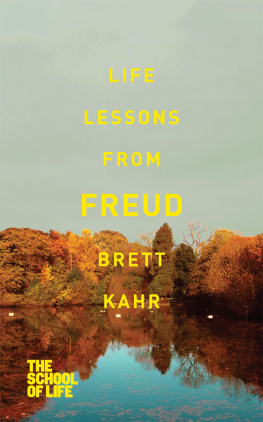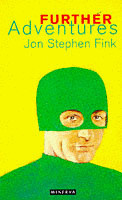Fink - A Clinical Introduction to Freud
Here you can read online Fink - A Clinical Introduction to Freud full text of the book (entire story) in english for free. Download pdf and epub, get meaning, cover and reviews about this ebook. year: 2017, publisher: W. W. Norton & Company, genre: Art. Description of the work, (preface) as well as reviews are available. Best literature library LitArk.com created for fans of good reading and offers a wide selection of genres:
Romance novel
Science fiction
Adventure
Detective
Science
History
Home and family
Prose
Art
Politics
Computer
Non-fiction
Religion
Business
Children
Humor
Choose a favorite category and find really read worthwhile books. Enjoy immersion in the world of imagination, feel the emotions of the characters or learn something new for yourself, make an fascinating discovery.
A Clinical Introduction to Freud: summary, description and annotation
We offer to read an annotation, description, summary or preface (depends on what the author of the book "A Clinical Introduction to Freud" wrote himself). If you haven't found the necessary information about the book — write in the comments, we will try to find it.
Fink: author's other books
Who wrote A Clinical Introduction to Freud? Find out the surname, the name of the author of the book and a list of all author's works by series.
A Clinical Introduction to Freud — read online for free the complete book (whole text) full work
Below is the text of the book, divided by pages. System saving the place of the last page read, allows you to conveniently read the book "A Clinical Introduction to Freud" online for free, without having to search again every time where you left off. Put a bookmark, and you can go to the page where you finished reading at any time.
Font size:
Interval:
Bookmark:
A Clinical
Introduction
to Freud
Techniques for Everyday Practice
Bruce Fink

W.W. Norton & Company
Independent Publishers Since 1923
New York London
A Norton Professsional Book
To my friends who provided such helpful comments on and criticism of this manuscript as it gradually became a book, including Yael Baldwin, Kristen Hennessy, Derek Hook, Mike Miller, Stephanie Swales, and Adam Szmerling. Their contribution was considerable, as were the suggestions of Deborah Malmud at Norton.
Contents
Because of the novelty of my therapeutic method, I see only the severest cases, which have already been under treatment [by other practitioners] for years without any success.
Freud, SE VII, p. 21 n
Words were originally magic, and even today words retain much of their ancient magical power. By words, one person can make another blissfully happy or drive him to despair.
Freud, SE XV, p. 17
The division of the psychical realm into what is conscious and what is unconscious is the fundamental premise of psychoanalysis.
Freud, SE XIX, p. 13
W HAT IS PSYCHOANALYTIC practice other than the invention and use of a whole series of techniques designed to access and impact the unconscious? Freud claimed that the theory of repression is the cornerstone on which the structure of psychoanalysis is built, and in this book I shall examine Freuds work with a view to explaining and exemplifying the myriad techniques he devised with which to get at the unconscious and thereby undo many of the ill effects of repression.
My impression, based on some three decades of psychoanalytic teaching, practice, and supervision, is that the most basic methods Freud developed for accessing the unconscious are no longer taught to the vast majority of students of psychology and psychoanalysis. The latter are, instead, instructed only in roundabout ways of broaching the repressedways that stem from what appears to be an almost century-long fascination (on the part of post-Freudians) not with the repressed itself but with the obstacles to reaching it, obstacles that Freud encountered early on in his work as he encouraged his patients to remember the events that led to the onset of their symptoms.
One such obstacle includes everything that falls under the heading of resistanceincluding such minor forms of resistance as embarrassment, moral compunction, and a sense that certain things simply are not talked about, being socially inappropriate, as well as more insidious and tenacious formsand analysts preoccupation with resistance gave rise to a whole trend within psychoanalysis known as the analysis of resistances.
All three of these endeavors have a fatal flaw, I would argue, which is to mistake the obstacle for the goal. An obstacle is something we attempt to get around, not focus on for its own sake. It is not by trying to understand every facet of resistance, defense, or transference that we are better able to have an impact on the unconsciousindeed, it might be truer to say that by focusing so exclusively on resistance, defense, and transference, the unconscious is forgotten.
Jacques Lacana French psychoanalyst (19011981) who is arguably the 20th-century analyst who took Freuds work the most seriously and attempted to extend and at times rectify it, which is why I will refer to his views on numerous occasions throughout this booksaid something about the May 1968 protesters in France, protesters who seemed determined to directly face off with heavily armed police, that might well apply to psychoanalysis as a whole: To run straight at the obstacles placed before you is to behave just like a bull. The point is to find a different path than the one where the obstacles lieor, in any case, not to be especially interested in obstacles.
Lacan views transference as arising primarily at moments of stagnation or breakdown in the dialectical movement of psychoanalysis, not as a quintessentially useful part of the therapeutic work (see Fink, 2007, circuit being required. Lacan suggests that when transference shows its face in an analysis, it is not the Holy Grail that tells us we are on the right track; rather, Transference is the means by which communication of the unconscious is interrupted, the means by which the unconscious closes up again. Far from being indicative of the signing over of powers to the unconscious, transference is, on the contrary, the shutting down of the unconscious (Seminar II, p. 130).
In this book, I shall focus primarily on the techniques Freud developed for going directly toward the unconscious, illustrating how we can use them and perhaps even improve on them today. (Readers interested in knowing how I would respond to certain people who have critiqued Freuds technique and biases, whether recently or not so recently, are referred to Freud undoubtedly gleaned a great deal from his own life experience, but also from all that he read and all that he heard from his patients. How could anyone ever know exactly what inspired a specific insight? Perhaps Freud himself would have been unable to tell us in many instances.
Nor shall I elaborate here on the particulars of Freuds intellectual development from the 1880s to the 1930s My concern is to highlight what in Freuds work seems to me to be of most direct relevance to clinicians who wish to bring out what an analysand (a term I prefer to patient, as analysand implies that it is the person who goes into analysis who does the lions share of the analyzing) is unaware of in order to impact his or her unconscious.
There are perhaps as many different readings of Freuds work as there are readers of it, and there are often wide divergences between the Freuds that various readers see. For Bruno Bettelheim (1982), Freud is a humanist who talks extensively about mans soul. For Frank Sulloway (1979), Freud is a scientist and a biologist of the mind. For some, Freud can be viewed as a phenomenologist, whereas for Lacanat least at a certain point in his workFreud is rather more of a structuralist. For Barbara Low, Freuds attitude to his material... might almost be called joyous, his exposition expressing profound emotion and the greatest freedom to use that emotion. For others still, Freud was little more than a misogynist. And for Herman Hesse, Thomas Mann, and Albert Einstein, Freud was above all a great stylist, a man of letters, and a master of the German language (he won, for example, the Goethe prize for literature in 1930).
For my purposes here, Freud will be viewed primarily as a clinician who developed a whole series of theories and practices in order to grapple with problems he successively encountered while treating patients over the course of some five decades. As we shall see (especially in ), Freudas a clinician who, like most innovators, learned largely by trial and errormade his fair share of mistakes with patients and, like everyone else, had his own personal flaws, rarely if ever living up to his own compelling theory of practice. I shall argue, nevertheless, that the rigorous theory of practice he bequeathed us goes well beyond his own foibles and failings as an individual and has a great deal to teach us even today.
Although I initially began to read Freuds work on my own, the take on Freuds work that I present here is heavily colored by Lacans many yearlong seminars, from about 1952 until the late 1970s, which arguably provided closer readings of Freuds work than any other course or text ever had. I studied these extensively during my analytic training in Paris in the 1980s and have been learning from them (and translating a few of them into English) ever since, finding them quite inexhaustibly fascinating.
To those potential readers who might be inclined to dismiss Freuds work out of handhaving heard that it is hopelessly out of date, his theories disproven by one and all, or that his theories were the product of a perverted sex maniacbut who are being asked, if not required, to read this book for a course, let me point out that for every expert in a scientific field who has supposedly debunked Freuds theories, there is another who endorses them and believes he or she has found evidence for them (see, for example, Adams, Wright, & Lohr, 1996; Baumeister, Bratslavsky, Muraven, & Tice, 1998; Muraven & Baumeister, 2000; Newman, Duff, & Baumeister, 1997; Rosner, 2000; Solms & Turnbull, 2002; Solms & Panksepp, 2012; Solms, 2015). We hear less about the latter, for whereas Freud bashing still makes for good copy (Crews, 1993; Webster, 1995), findings that corroborate psychoanalysis are no longer considered newsworthy. In every scientific field, researchers often disagree as to the validity of theories for decades, if not centuries (consider those proposed by Galileo and Darwin, and theories like those of the ether and string theory)this is a regular feature of scientific debate. I would ask you to try to momentarily set aside the views of the competing experts and judge for yourselves as to the clinical usefulness or uselessness of the theories and practices I will present herethe proof, after all, of a theory designed to guide psychotherapeutic practice is in the pudding: Does it help you help your patients or not? (I do not see how the clinical validity of a theory could be seen to depend on the character of its inventor, as if we could all agree, in any case, whether someone was a good person or not. When we learn about new theories in the sciences that seem to explain many things we find in nature, or when we are moved by poems, songs, or novels, do we rush to discover if their creators were good, honest, upright people before deciding whether their scientific, literary, or musical productions were valuable?)
Next pageFont size:
Interval:
Bookmark:
Similar books «A Clinical Introduction to Freud»
Look at similar books to A Clinical Introduction to Freud. We have selected literature similar in name and meaning in the hope of providing readers with more options to find new, interesting, not yet read works.
Discussion, reviews of the book A Clinical Introduction to Freud and just readers' own opinions. Leave your comments, write what you think about the work, its meaning or the main characters. Specify what exactly you liked and what you didn't like, and why you think so.

